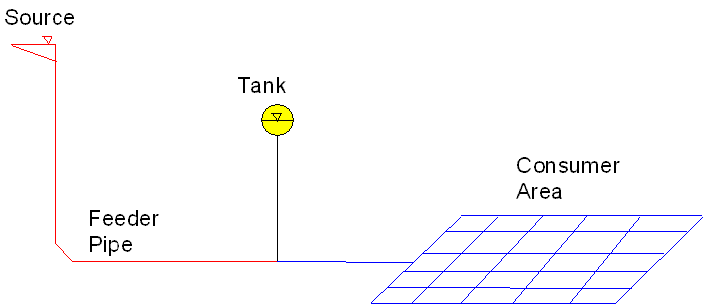There exists a trade-off between pipe cost and storage cost in all water distribution systems which include storage tanks for the purpose of balancing peaks in the water demand. This trade-off can best be explained by means of a simple pipe network such as shown below. Note that all the consumption occurs downstream of the tank. The feeder pipe is therefore the only pipe which influences the required balancing storage for the tank.
Simple Pipe Network Layout

If the feeder pipe is a large pipe with a capacity (Q) which exceeds the instantaneous peak in the downstream demand, no balancing storage would be required. If Q is marginally lower than the instantaneous peak demand, a small tank would be required to supplement the feeder pipe during short periods of imbalance. The lower the capacity of the feeder pipe, the longer and more frequent the periods of imbalance and the more the required storage. If the capacity of the feeder pipe is so low that it only equals the annual average demand rate (G), a very large tank may be required to balance seasonal fluctuations in the demand. The trade-off is clear. To find an optimum, decreasing pipe costs have to be traded off against increasing storage costs.
A feeder pipe capacity of lower than G is not feasible. This would result in over-year shortages having to be supplied from the tank, which would require an infinitely large storage volume.
If the tank in the figure was situated inside or downstream of the consumer area, all the pipes in the network, and not only the feeder pipe, influence the balancing capacity of the tank and need to be considered for the pipe cost/storage cost trade-off.
To optimize in terms of total system cost it is therefore very important that tank cost is included to reflect the trade-off between tank cost and pipe cost. The question of tank-feasibility is of equal importance. It may very easily happen that a given combination of pipe sizes is adequate in terms of the prescribed pressure constraints, but will cause one or more of the tanks in the system to drain even while the demand rate in the system is lower than the annual average demand rate, rendering the combination non-feasible. Without calculating tank sizes during the optimization such non-feasible pipe size combinations are impossible to identify.